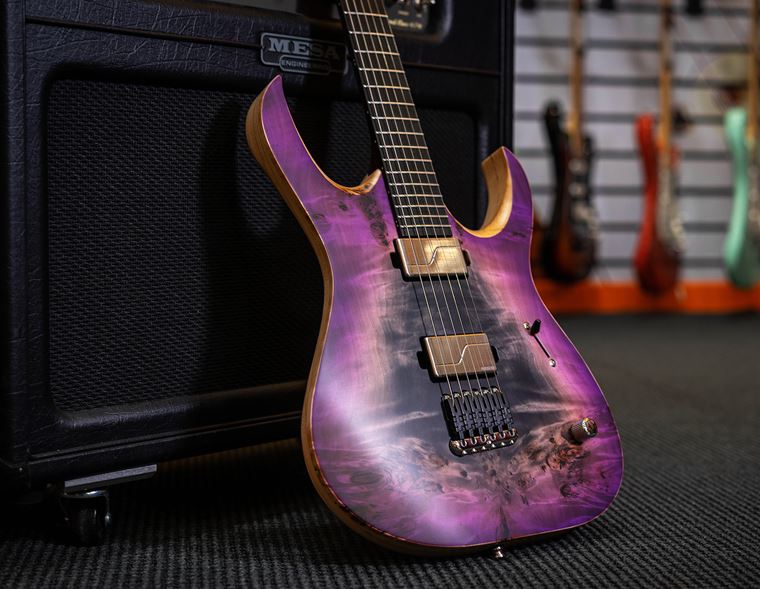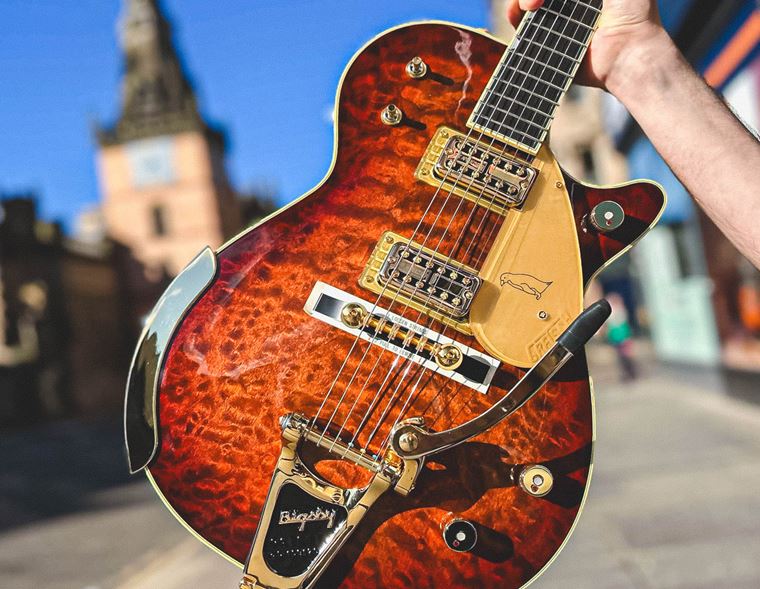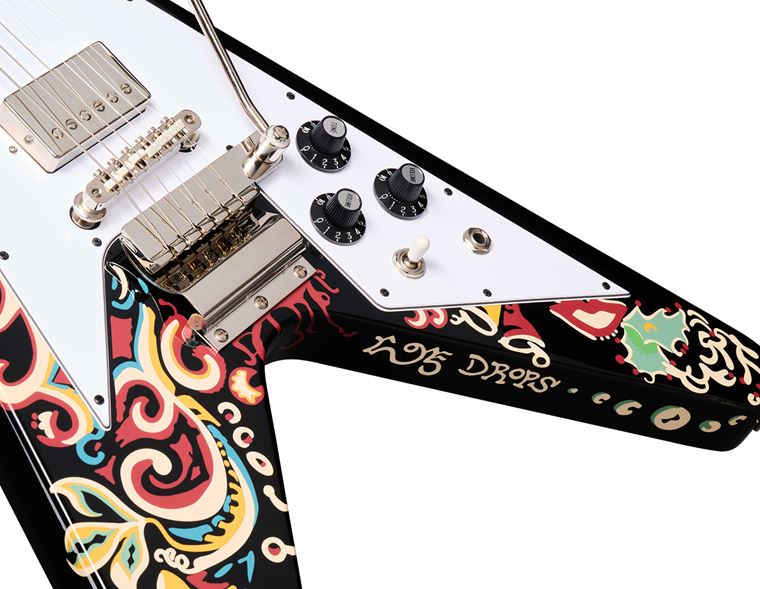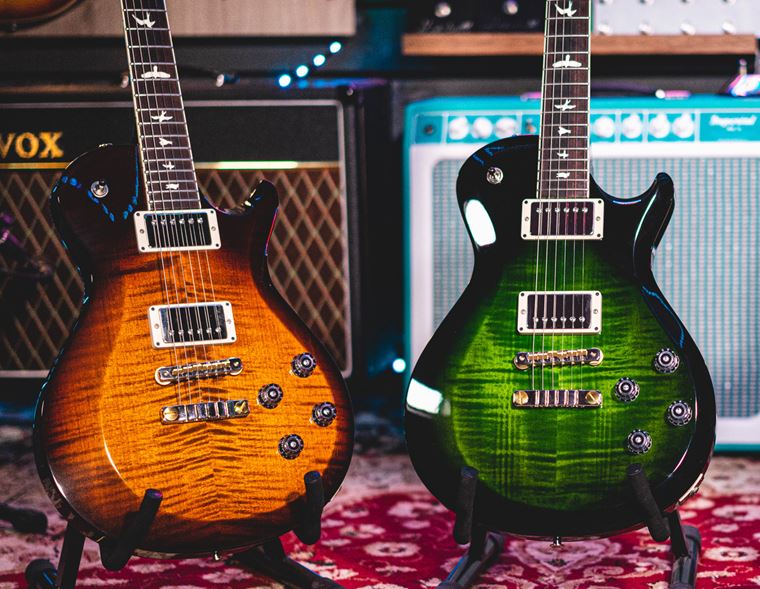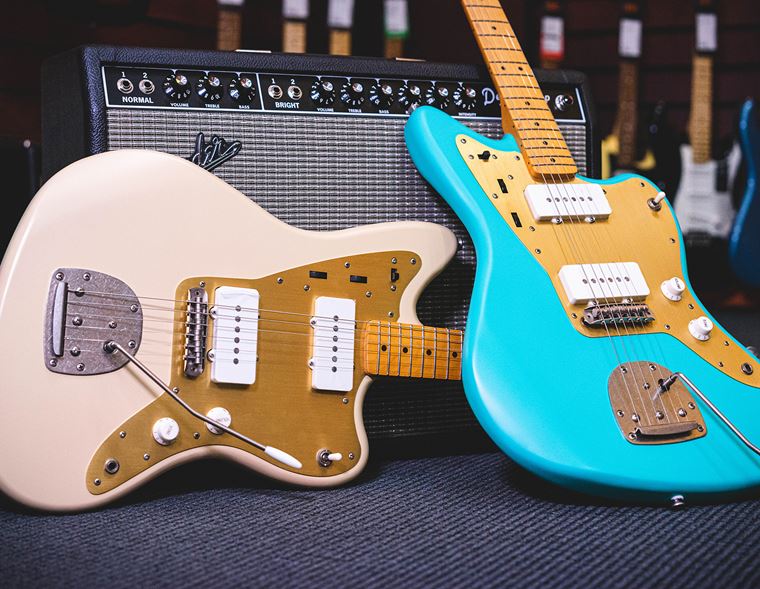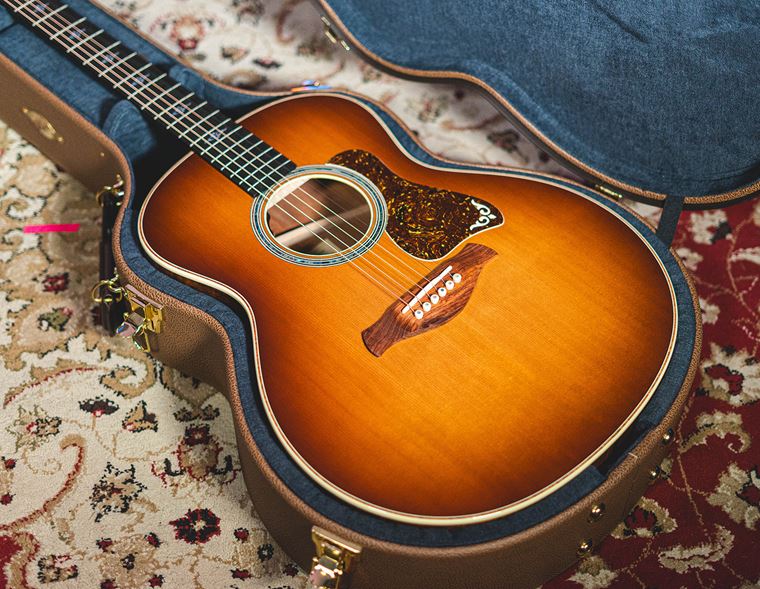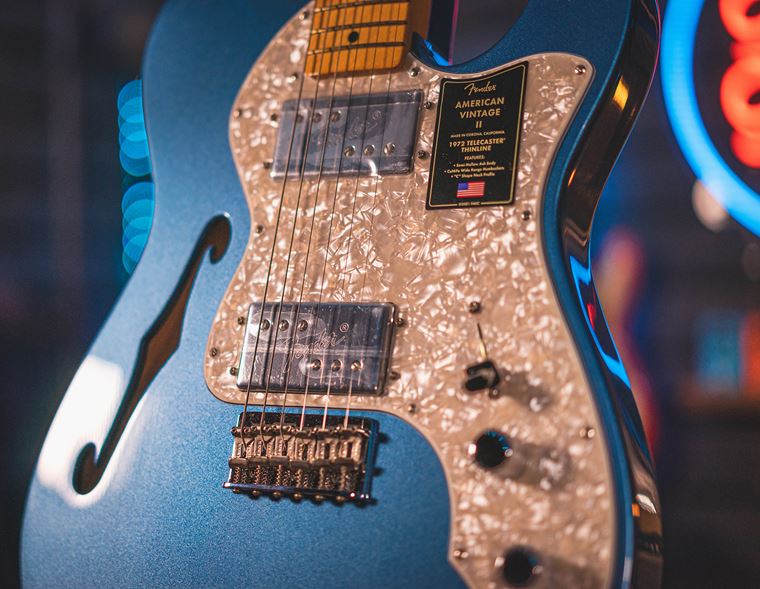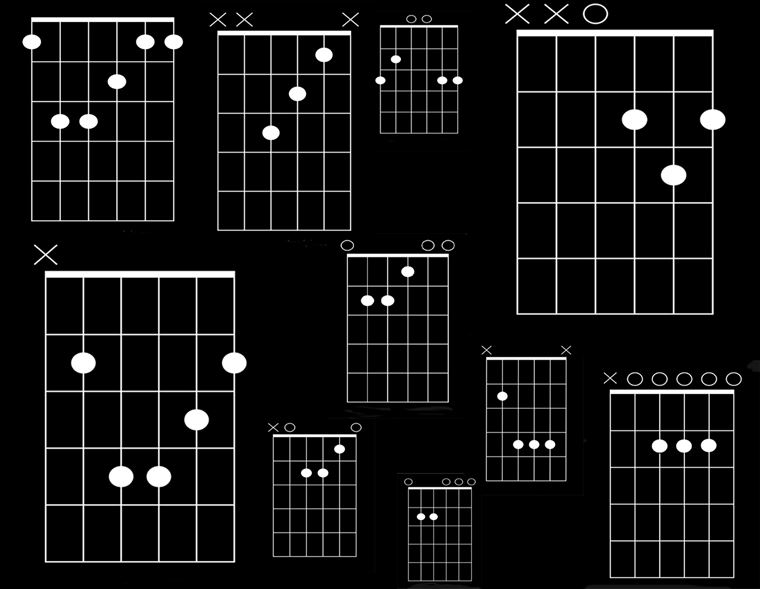EASTCOAST: The Most Underrated Guitar Brand? (Updated for March 2025)
Published on 18 September 2024
Beginner guitarists, lend me your ear! You want to learn to play the electric guitar, you’ve looked to your heroes and seen names like ‘Fender’ and ‘Gibson’ emblazoned on their instruments, so naturally you want the same. The trouble is, now that you’ve started looking into these guitar brands, you’ve also realised that pro guitars come with pro price tags, and even the most affordable Fenders and Gibsons are perhaps outside the scope for a first instrument.
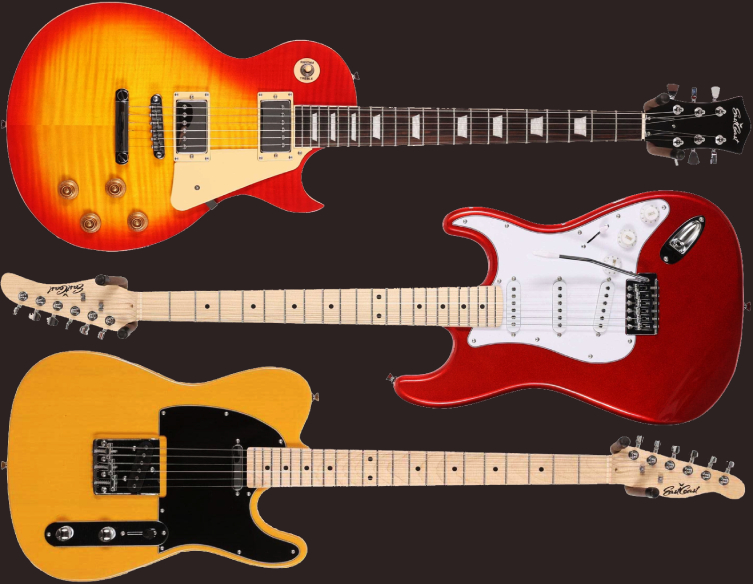
This brings us to today’s blog subject. What is a good, affordable brand to learn on? Something that looks like those classics, that plays nicely and sounds good, but costs a fraction of the price? One brand to check out, in my opinion, is EastCoast.
Contents
- The Three Most Famous Guitars in the World
- EastCoast T1
- EastCoast ST1
- EastCoast L1
- Further Classics - the EastCoast G35 and GS1
- New for 2025 - the EastCoast HM1
The Three Most Famous Guitars in the World
EastCoast guitars are designed specifically to serve those on a budget: beginners looking to take their first steps into the world of guitar playing who want something recognisable that doesn’t break the bank. EastCoast guitars answer this requirement with a host of instrument models in a myriad of shapes and colours, but today we’re going to check out three models in particular.
EastCoast themselves are something of an underrated guitar brand: lesser known but good quality, they make beginner instruments at price points that are very attractive in today’s climate. Whilst we’d never presume to imply that these guitars are direct competition to the likes of Fender and Gibson - they clearly are not - but as legitimate choices for the aspiring guitarist, EastCoast pile on the bangs for the proverbial buck.
Now, it’s no secret in the guitar universe that certain designs from the 1950s still hold sway over the majority of players’ taste right up till today. Three famous guitar designs are almost the blueprint for much of what the industry offers - at all price points, not just the beginner level - and you’ll see infinite varieties of these as you progress as a player.
What are they? Okay, there is the Fender Telecaster (which we’ll refer to as the ‘T-style’, so as to disambiguate from the parent brand), which was the world’s first mass production electric guitar. It’s still one of the three most popular, and for simple effectiveness, it doesn’t get more direct. You’ll have seen a diverse range of guitarists play a Telecaster, from Keith Richards to Bruce Springsteen.
Then there is the Fender Stratocaster, released a few years later and what most people now identify as an ‘electric guitar’. It’s easily the world’s most popular and famous guitar style. We’ll refer to guitars based on the Stratocaster as the ‘S-style’. This is the style played by Jimi Hendrix, Jeff Beck, Eric Clapton and thousands of others.
Finally, there is the Gibson Les Paul, an altogether different style of instrument. We look into what makes this style different a little later, but it’s the other most popular guitar design and we’ll call this the ‘Single Cut’ due to it’s shape having one corner shaped (cut away) for fingerboard access. Les Pauls (the name comes from the famous jazz guitarist who helped develop the design) have been played by Jimmy Page, Billy Gibbons, Peter Green and lots of other rock legends.
In terms of popularity, that’s the big three. As I've already said though, genuine examples are not cheap, so brands like EastCoast build their own unofficial replicas (taking care not to follow the design too closely for legal reasons!) at vastly more affordable prices. Today, we’re going to look at what you can have from EastCoast that relate to these famous guitars, and why you’d want to buy these to learn on.
EastCoast T1
First up, the T-style EastCoast T1. This is as stripped back and functional as guitars get, with two pickups, a bridge that strings through the guitar’s body and a classic ‘slab’ body with a single cutaway for high fret access. From country styles to indie rock and every genre in between, this EastCoast T1 will get you there. These types of guitar translate well to the affordable market since they are inherently simple designs, and EastCoast have done a great job to not only approximate the outline and design, but also bring a convincingly playable feel to the neck. A good maple neck is used here, with a pleasingly flat 12” radius to the fingerboard (the larger the number, the flatter the fingerboard is) that is actually something you don’t often see at this price range!
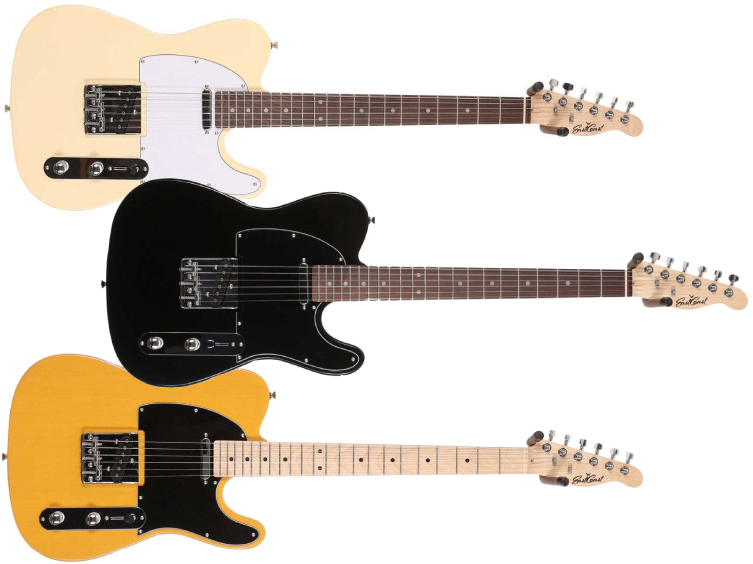
A set of ceramic pickups deliver a range of tones that work well across styles, and a control panel that comprises of a volume knob, tone knob and three-way ‘blade’ selector put everything you need right there at your hands.
A good T-style guitar is like having a good wrench in your DIY toolbox: it’ll always come in handy and you’ll be constantly glad to have it! EastCoast have this guitar available in three colours, including Vintage white, all Black (with a rosewood fingerboard to complete the look and give a slightly different feel) and our favourite: Butterscotch blonde. Instant Boss vibes? We think so!

If you want a solid guitar that’s easy to look after, tune and maintain, then the EastCoast is a contender. It has that timeless look, it’s highly playable and the pierce is very attractive.
EastCoast ST1
Our next choice is for the S-type, the EastCoast ST1. Super versatile and a good likeness for its iconic inspiration, this model is easy to recommend. With its contoured body and extra electronics (there are three pickups and two tone controls on the ST1), the value on display is considerable. You’ll get 5 tonal options from the blade selector, including two choices that we guitarists refer to as the ‘quacky’ noises, which S-type guitars are famed for.
On top of that, you get a wonderful choice of eye-catching finishes including Shell Pink and Lake Placid Blue, such things as you’d never seen on beginner guitars from days of yore!
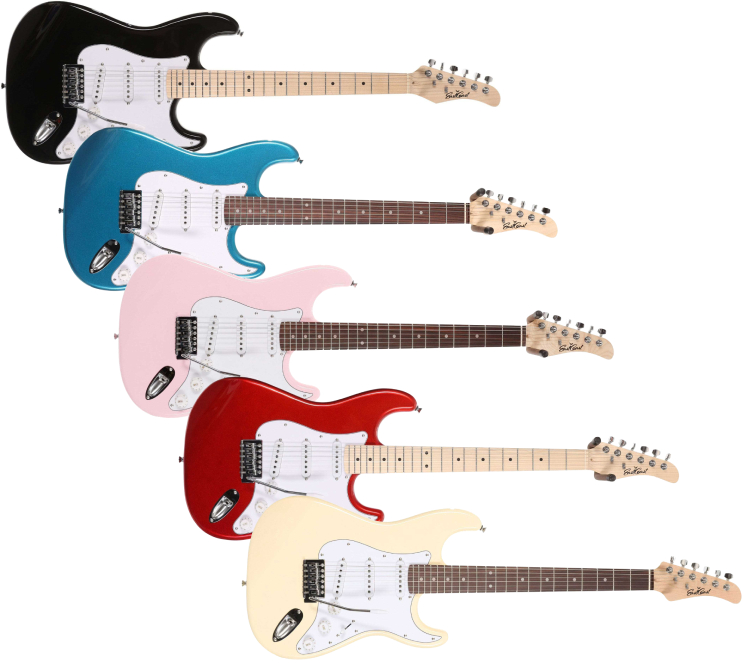
Being as this is an S-type guitar, there is also a tremolo bridge fitted to the ST1. Also known as a ‘whammy bar’, the bridge on this guitar has a mechanism that employs a metal bar to manipulate the pitch of notes as you depress the bar. It sounds way cool (think of Hendrix recreating carpet-bombing sounds during his take on Star-Spangled Banner) but since it’s a mechanical device that is effectively rubbing metal (strings) against metal (the bridge itself), there will always be tuning discrepancies involved when using one. Whilst it’s true to say that more expensive units handle this problem better, it’s certainly not something that magically goes away on £1000+ guitars either! Do keep that in mind: whammy bar frenzies are lots of fun but you’ll be hopelessly out of tune by the end of it!

That said, many S-type players don’t use the bar at all, and just enjoy the comfy body contours and wide selection of tones on offer. If you want versatility, a selection of cool colours and a comfortable instrument to learn on, the EastCoast ST1 is a hard choice to top.
It’s worth also noting that there’s a cool additional sub-model connected to the ST1. The EastCoast ST2 is everything we just mentioned apart from the substitution of a humbucking pickup in place of the customary single coil unit at the bridge. It looks like two single coils shoved together but that isn’t exactly the case. What’s important is that humbucking pickups deliver a more powerful, harder sound. If you like your hard rock and metal, we’d recommend to definitely opt for this version, in what is known as an HSS (humbucker - single coil - single coil) pickup configuration. It has its own colour options too, including a mean looking metallic black model!

EastCoast L1
Our third choice today is the EastCoast L1, and of course it is an affordable take on that famous Singlecut guitar beloved by 70s rockers. Beautiful and ornate, this style of guitar screams ‘rock god’ more than most! Now, you may see straight off the bat that this guitar is twice the cost of the other EastCoast models we’ve checked out today, but there are good reasons for that, as we’ll see.
Firstly, the neck is actually glued into the body as opposed to bolted on. Glued necks are more expensive and time consuming to produce (hence reflected in the guitar’s cost) but they add important elements to the instrument’s tone and sustain. Singlecut guitars are famous for their weighty, rich tone and so losing this feature would rob the guitar of its identity.
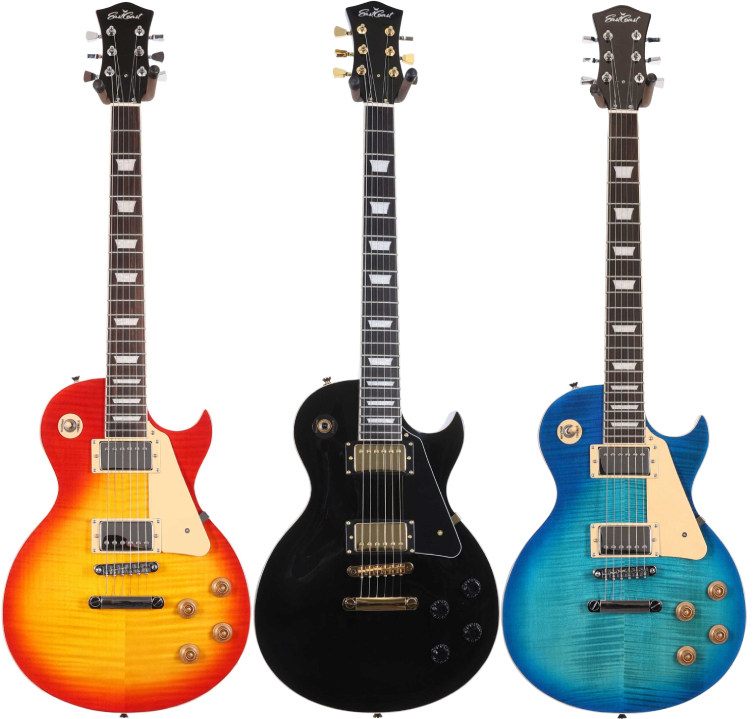
On top of that, the body itself features a especially shaped top, carved more like a violin than a flat electric guitar. In addition, this EastCoast L1 manages to have a veneer of flame maple on the top for a very impressive, opulent look. We do not expect to see this on a guitar at this price and so find it rather impressive! In fact, the black model does not sport this figured veneer, but you get gold hardware instead.
These are the main identifying markers that separate this particular guitar style from those that we’ve already seen. There are other decorative elements, too, such as binding around the body and neck, special fret markers (we can that shape a trapezoid) and metal covers over the pickups, which are both humbuckers.
Sonically, you’ll find a bigger sound on offer here, with lots of depth but less ‘snap’ that the first two guitars. This is due to the thicker body, the set neck and the humbucker pickups. The playing feel is different too, since the neck sits at a slight back angle to the body, compared with the straight flatness of the ST1 and T1. Which is best? Neither, so do try both and you may find you have a preference! One thing to note about this model is that it has a slightly shorter scale length. This refers to the distance of ‘working string’ on the instrument, from the bridge to the nut. Our first two choices today have a scale length of 25.5” and this L1 guitar has 24.75”. It may not sound like much, but it does make the guitar feel pretty different when playing, and perhaps easier for a beginner due to their being ever so slightly less tension in the strings. Again, try both and see if you have a favourite.
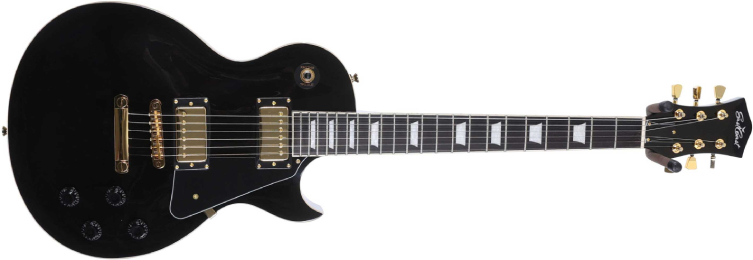
The important takeaway here is that the EastCoast L1 is really a lot of guitar for the money! Like the others, this is a pleasure to play, and it’s a beautiful looker too, whether you opt for the gloss black finish we mentioned earlier or choose one of the eye-catching bursts available: Blue burst and Heritage Cherry burst.
Further Classics - the EastCoast G35 and GS1
So, those three designs are based on possibly the most well-known electric guitar designs of all, but that’s not the whole story! There are two further models that echo some real classics, so let me show you those now.
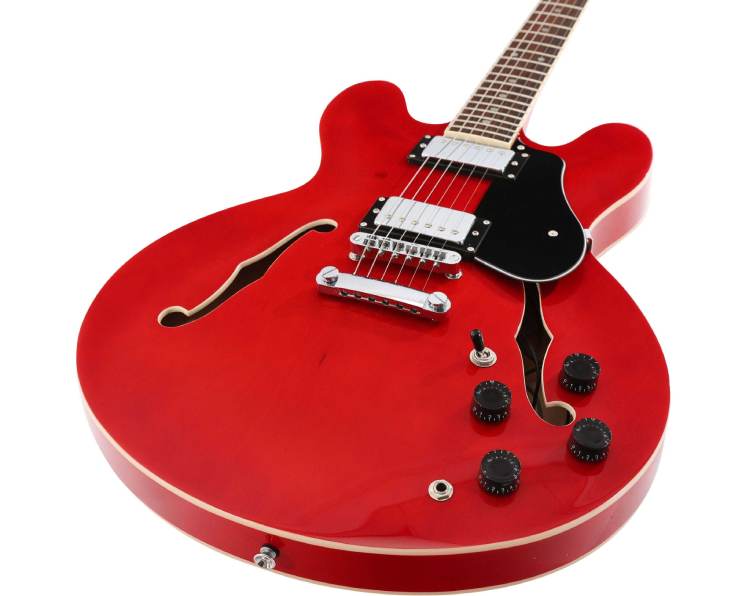
First off, the EastCoast G35 is what we refer to as a ‘thinline semi acoustic’. This style is based on the famous Gibson ES-335 and is a great all-rounder, particularly for indie rock, blues and jazz styles. Similarly to the L1 model, the G35 has a slightly shorter neck (it also has a 24.75” scale length) and a pair of humbucking pickups for an easy playing feel and a warm sound.

You’ll notice the violin-style f-holes in the body? These are here because the EastCoast G35 is semi-acoustic. This means that the body is solid down the middle but has large hollow areas on each side. This brings the weight down and also influences the sound, making it more mellow sounding than the likes of the L1. You can still definitely play rock music on this, though! In fact, squint your eyes a little and it looks pretty close to Marty McFly’s guitar in Back to the Future!
The EastCoast GS1 is a devil-horned rocker based loosely on the famous Gibson SG guitar. Played by such bands as AC/DC and Black Sabbath, the SG is a certified rock guitar and then some, and EastCoast’s affordable and attractive take on it is well worth trying out! The GS1’s design allows your fingers access to those high-up frets, and the slim body means that the guitar is not too heavy on a strap either, which is an important consideration for those with ambitions of heading to the stage eventually!

New for 2025 - the EastCoast HM1
I’ve jumped back into this blog to add another new EastCoast model to the list: the EastCoast HM1. This is a great choice for any budding players who are setting their sights on lead guitar playing. Why? Well, all guitars are good for lead guitar playing, but this one benefits from having 24 frets - two or three more than some other guitars - so you can play some really high-pitched, adventurous guitar parts on it.
The HM1 is great for heavier music thanks also to the dual humbucking pickups, which are higher in output than in other EastCoast guitars. This means you get a louder, hotter sound from this guitar, which is perfect for hard rock and metal. The sleek, contemporary styling also suits the vibe and attitude of heavy music, so if your goal is to head in that musical direction, I reckon this EastCoast HM1 is a great place to focus your attention!

The EastCoast Range
Today we’ve looked at six examples from EastCoast’s range. There are many more available, and what they all have in common is a decent level of build quality, recognisable good looks, easy playability and a nice sound.
On top of that, every single EastCoast guitar has been checked, set up and tested by our guitar techs, so they'll be playing at their best when they reach you! What more could you ask for in a beginner’s electric guitar? We think EastCoast are a legitimate choice and an underrated brand. Visit us, try a few out and see what you think!


